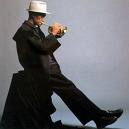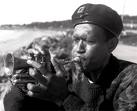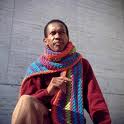Reflections of Don Cherry: An Adventure in Sound
Posted by reflectionsinrhythm on November 22, 2009 · 1 Comment
 In memory of music innovator Don Cherry: born November 18, 1936 Transitioned: October 19, 1995…
In memory of music innovator Don Cherry: born November 18, 1936 Transitioned: October 19, 1995…
The following is from an interview / conversation that I was honored to share with one of music’s truly creative sources in 1994. The interview was originally published in the August 1994 issue of Jazz Now Magazine.
Don’s soulful creativity can be heard on countless recordings as a leader and contributing guest. Check him out as you check this out...
THE MUSICAL EXPLORATIONS AND REALIZATIONS OF DON CHERRY
Over the past three and a half decades Don Cherry has created one of the most unique voices in modern music. From his major introduction to the public as a member of the ground-breaking Ornette Coleman Quartet of the late 50s and early 60s to his numerous collaborations with some of the most adventurous and creative minds in music, the sound of his pocket trumpet has become an instantly recognizable notice that a musical journey is about to take place.
Travels through sound and music with Don Cherry have included Sonny Rollins, John Coltrane, Steve Lacy, Gato Barbieri, Archie Shepp, Albert Ayler, Hilton Ruiz, Dewey Redman, Carla Bley, Peter Apfelbaum and most of the true innovators of the past thirty years. Regardless of where the journey may end for the musicians and the listener, the take off point for Don was “Harmolodics”, the musical concept that Ornette Coleman introduce to a dis-believing group of musicians and audiences in the mid 60s.
Although Ornette’s theories weren’t easily accepted by most at the time, Cherry expressed a great interest in the things Ornette was trying to express musically, as he remembers, “When I first heard Ornette I was playing with another group with Billy Higgins in Los Angeles. We heard Ornette and Blackwell (Ed), they were on the scene, that was back in the 50s.” Soon after meeting with Ornette, Don was a regular member of practice sessions led by Coleman. “I started practicing with him with saxophone player James Clay. We would go to Ornette’s house to study. It wasn’t just practicing it was studying, which it still is.”
The theory of “Harmelodics” may have been considered a musical breakthrough for some, but there were countless others who considered it a bad joke at best or an insult to music and musicians at worst. As Don looks back on these early years he reflects, “I think the improvising, the solos were more disturbing or advance for people to hear, but the compostions were so melodic I think that’s what brought the people in close to the music. There was an audience of people that loved it or they didn’t like it and felt intimidated by the music. With musicians that was one kind of reaction, because the musicians would judge this kind of music by what they were doing”.
As many people would discover with time, “Harmolodics” proved to be a legitimate musical form with a life of it’s own. “Ornette has his own clef”, Cherry explains, “When he writes his music he has the Treble clef, Harmolodic cleff, which is like the figure eight, and the Bass clef.” “He would write things where I would play the melody and he would write a harmony to that melody and the harmony that he would write would end up being the melody and the first melody ends up being the harmony.” A prime example of this technique is the Ornette Coleman recording, “Skies of America” which also includes Dewy Redman.
Through out his career, Don Cherry has been heard in a varied array of musical settings, from straight Be Bop to music of India, Africa and other corners of the world. Cherry’s eclectic taste in music can be traced back to his childhood; “I was born in Oklahoma and I have American Indian, Chaktaw, parents so I’ve always heard gospel music and American Indian music and the blues. My father was a bartender and through him I heard a lot of dance music, Fletcher Henderson and Artie Shaw, Count Basie, Duke. I was always around the music at dances and gay events.” “My mother was in a club where there were twelve women and they each had a month that they would give a party.”
During his junior high school years Don picked up the trumpet and hasn’t put it down since. “I played a lot of Latin music when I started playing trumpet, which I started on in junior high school. I’d play at weddings and places like that. My cousin knew all the Latin cats. He was a merchant marine and on his ship he’d bring records back and turn me on to Latin music.” The Los Angeles jazz scene also became a learning source. “When I started playing we used to go hear Wardell Grey and Dexter Gordon, and check out that whole scene…Sonny Criss, and Hampton Hawes. That was the scene around the neighborhood.” “Eric Dolphy was always helpful, and Frank Morgan was very helpful to us young kids trying to learn.”
When it came to trumpet players, Cherry listened to and learned from the top names of the day. “My favorite trumpet player was Fats Navarro even though I always listened to Miles Davis and Dizzy Gillespie. The trumpet player who was on the scene in California that I always loved was Harry “Sweets” Edison.
As time moved on Don became one of the musical explorers of time. Though known mainly as a trumpet player, he’s also studied and recorded with instruments of different cultures and from different countries. He give this insight, “It’s one thing to try to play exotic, but to study a music, like Indian music, to study it and realize the scales and different things you gain a respect for the culture and the music. Playing with George Russell really opened that up for me.” “I learned that with Japanese music they have morning scales and afternoon scales. The first scale played has a half tone in it. They have 36 notes in an octave while we (Americans) have only 12. They have 36 because of those minor tones. That half tone is how meditation and the sensitiveness of your feelings moves and slides. A good example of that type of playing in jazz, a master of that was Johnny Hodges, That half tone is a very important tone because it’s the first tone of the day. The whole tone is more for dancing.”
The Doussin gouni has been a frequent instrument of choice for Don Cherry as well as a Chinese ceramic flute called the Hsuan, also known as the plum flute or earth flute. He explains his introduction to and fascination with the Hsuan, “When I was teaching in 1970 I was thankful and happy to be around some of the best western ceramic craftsmen up there. There was a family who had learned the Japanese style of ceramic making. One son, Eric O’Leary introduced me to this Chinese instrument, the Hsuan. Eric would make the flute and before he would put it in to bake it I would add the holes.”
The continued search for musical expression led to the formation of the group CODONA which featured Colin Walcott, Nana Vascancelos, and Don. Of this group Don says, “We stayed together until Colin died, he was the synthesis that brought the group together. Nana and I met playing with Abdullah Ibrahim. After recording on a project of Colin’s called “Grazing Dreams” for ECM records we all got together as a group, because of the instrumentation. I mean Nana was playing percussion and different instruments like the tabla. Colin would play the finger piano, and we would include the sitar and we would have all of these different sounds for compositions that we would write together. We would also have traditional compositions for the different instruments we played.”
Now matter what type of music he’s playing, for Don Cherry there’s a strong connection between society, politics and music and the best example of this connection in America is Rap. Comparing today’s rap messages to forms of expression used in the past he observes, “Zulu poetry has always been passed on for many years, but has not been written down and what’s happening in rap is poetry bringing out the problems and looking for solutions for what’s happening now.”
Over the past few years Don has recorded a couple of projects for A & M records, one featuring his old friend James Clay (Art Deco), and another where he’s joined by Peter Apfelbaum and the Heiroglyphics Ensemble (Mulit Kulti). Of the Heiroglyphics Ensemble Cherry states, “I’ve listened to Peter and the way the band has developed over the past few years and it’s been exciting. For me playing with this group is true bliss and heavenly to play with this group.” He also considers the Heiroglyphics Ensemble one of his main reasons for moving to the Bay Area in 1988.
As busy as he may get with other musical commitments there’s always time for Ornette. Commenting on a recent performance with his musical soulmate that also included Ornette’s son Denardo on drums and bassist Charnette Moffit, son of former Coleman bandmate Charles Moffit, Cherry says, “Charnette was great, he’s growing everyday with the music and Denardo has been playing ever since he was 13. Ornette is still the same way he was when I met him. Practicing, writing, composing, always around music. His whole life is music. It was really beautiful watching him and Denardo together.”
It seems that time hasn’t changed Don much either. From his first musical introduction in 1959 to the present he remains as creative, curious and adventurous, and always looking for more passengers for the next musical journey…..Listen
Filed under Interviews, Uncategorized · Tagged with A&M Records, Billy Higgins, Charles Moffit, Charnette Moffit, Codona, Colin Walcott, Denardo Coleman, Dewey Redman, Don Cherry, doussin gouni, Gato Barbieri, Harmolodics, Heiroglyphics Ensemble, Jazz Now Magazine, Multi Kulti, Nana Vascancelos, Ornette Coleman, Peter Apfelbaum, Skies Of America, Sonny Rollins, Trumpet

Terrific venue and words from a very soulful and innovative cat. Thank you!